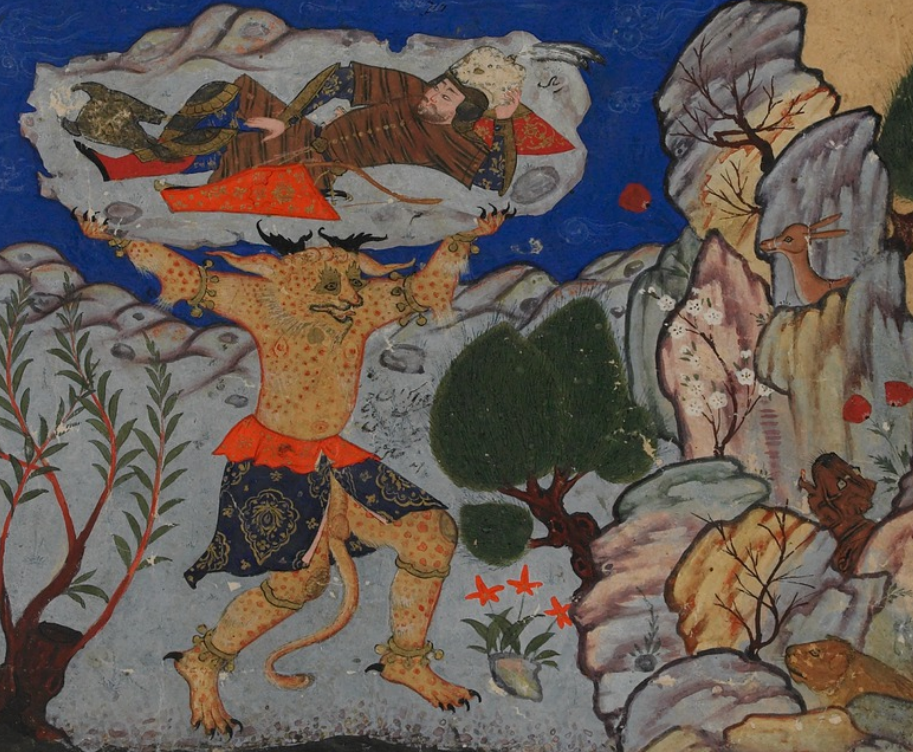Blog
(Note: This post was rescued from Medium, where it first appeared. It is here for archival purposes.)

Div Akvan Throws Rustam into the Sea. Source: https://www.wdl.org/en/item/3137/
شاهنامه
Shahnameh
The Book of Kings
These are the names for what, given its modern centrality to the ethno-national cultural identity of a vast swath of the world, is perhaps the most important work in Persian literature. Its author, known as Ferdowsi, began its composition in 977 AD and completed it in 1010 AD. It consists of 50,000 two-line couplets, called distichs, and spans the history of Iran from the dawn of time to the fall of the Persian Empire, giving it the distinction of being the world’s longest epic poem written by a single poet. Its influence today extends from modern-day Iran, Tajikistan, and Afghanistan to Armenia, Georgia, Turkey, and Azerbaijan.
I mentioned in my introductory post for the reading series that the selected works were often difficult to categorize cleanly between sacred and profane. This is one such work, for complicated reasons. Alone, Shahnameh does not seem to be regarded as a sacred text. That said, Ferdowsi incorporated characters and stories from the Avesta, which is the primary collection of sacred texts of the Zoroastrian faith, still practiced today. Zoroastrianism, I should remind you, was one of the influences of both Judaism and Christianity, and therefore has significant claims on Western tradition.
But why should we read it?
My primary reasons for reading it are 1) it looks like a good collection of stories, most of which I am entirely ignorant of; and 2) it deals with aspects of humanity that are near and dear to many a modern reader, aspects such as free will, the problems of evil, power, and the inner struggles of humanity. Like other epics, it combines the natural and the supernatural, encompasses a range of human behaviors and activities, and includes plenty of action. There are demons and heroes, battles and romances, family rifts, and struggles both interior and exterior. It was written primarily to tell a particular story, the story of Persia, and so it has historical value even aside from the question of literal truth. It would be one thing if this work had faded into obscurity, a historical footnote. That it has not is all the more reason to peer into it. Like other such works, its power lies not in its truth value, but in how it has been interpreted and integrated into the cultures it continues to serve. It is a perception of the past that resonates still today among a great many people, and it stands as window into the minds of those who may seem different from us. Read it as a means of broadened understanding of the human experience in all its glory and tragedy.
As with most of the texts I’ve picked for the year, this one has been the subject of the incomparable BBC Radio series In Our Time, to which I wholeheartedly recommend you begin listening (you can listen directly on the website or subscribe via your favorite podcast app). The In Our Time episode focused on Shahnameh is here. In it, you will get an overview, a history, and some analysis of the work by the assembled panel, comprising experts on various aspects of the text, its author, and its surrounding culture.
During the month, I will endeavor to post collected quotes and excerpts, musings, and any notes I think might be of interest in relation to Shahnameh. Each of these subsequent posts will be tagged appropriately so that they may be found easily, but if I remember to do so, I will also come back to this post and add links to each of the subsequent posts that relate to it.
This will be my first reading of Shahnameh. I hope I can make it through within a month, but there are no guarantees. Whether you’ve read it before or would like to try it out for the first time, I welcome any and all fellow travelers.
Further reading and resources
Wikipedia is a good starting point: https://en.wikipedia.org/wiki/Shahnameh
World Digital Library has a digitized manuscript of 215 illustrations from the work: https://www.wdl.org/en/item/8966/